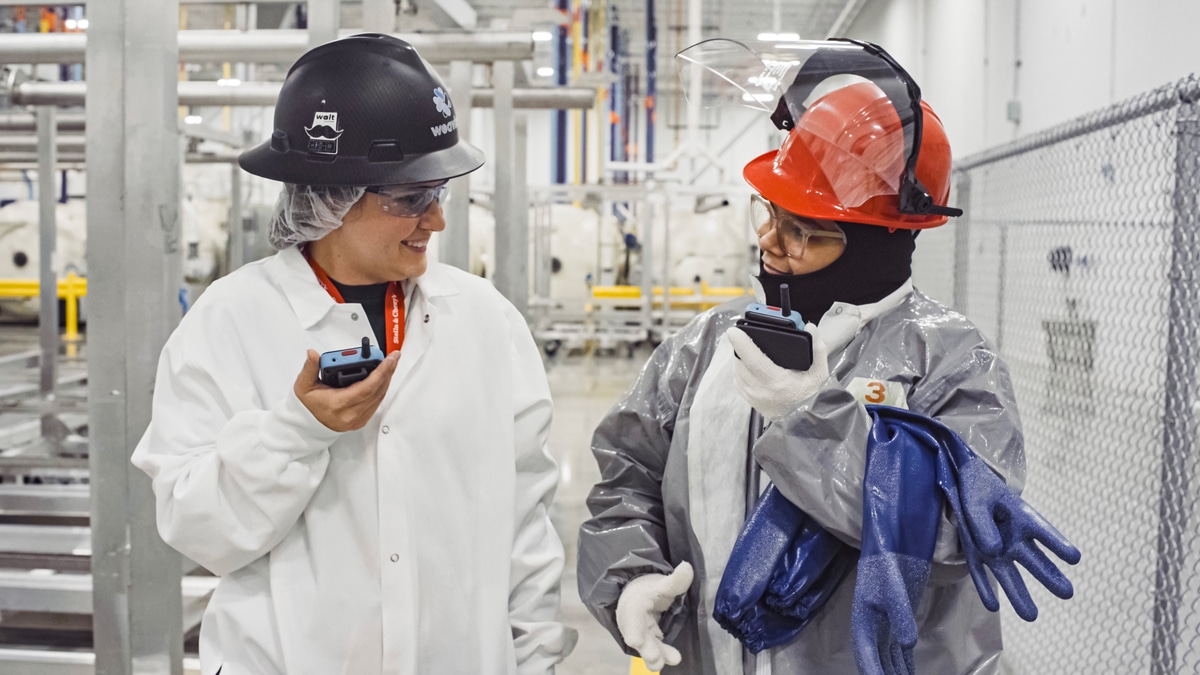Plant managers face daily pressure to boost productivity, maintain quality, and keep workers engaged — all while controlling costs and staying competitive. Fragmented communication, inefficient processes, and high turnover on the frontline all make optimizing workforce output more challenging.
To address these issues, organizations need actionable insights and a focused approach. In this guide, you’ll learn the 3 key strategies to improve workforce performance, so you can strengthen team communication, use technology to eliminate inefficiencies, and support worker well-being.
Key highlights:
- Workforce performance is the measure of how effectively frontline employees meet productivity, quality, and efficiency goals — and it directly impacts a company’s competitiveness.
- Real-time communication and modern technology help eliminate inefficiencies, reduce downtime, and keep teams aligned on workplace performance goals.
- Prioritizing worker well-being improves engagement, lowers turnover, and builds a sustainable, performance-driven workforce.
- The Walt® Smart Radio System by weavix® enables organizations to improve worker performance, supporting stronger communication, streamlined operations, and healthier frontline teams.
What Is Workforce Performance?
Workforce performance is the measure of how effectively employees execute their tasks to meet business objectives. In manufacturing, this performance includes productivity, quality, availability, and efficiency metrics — all of which have a direct impact on operational success.
High workforce performance typically includes:
- Availability: The percentage of scheduled time employees spend on productive work. For example, if operators are scheduled for 900 minutes and face 120 minutes of unexpected downtime, their availability is (900 – 120) / 900 = 86.7%.
- Performance: The rate at which output matches the established standard. If the standard is 60 units per hour and employees produce 700 units in a shift with 780 available minutes, the performance is 700 / (780/60*60) = 89.7%.
- Quality: The percentage of output meeting standards without rework. If 700 units are made and 670 are saleable, the quality rate is 670 / 700 = 95.7%.
Monitoring these factors enables plant managers to identify areas for improvement, implement strategies, and boost overall efficiency.
Keep reading: How to build a better frontline employee experience with smart radios

Top Benefits of Managing Your Frontline Worker Performance
Frontline workers are the backbone of manufacturing, impacting efficiency, product quality, and business results every day. When managers take an active role in guiding and supporting worker performance, they create conditions where teams are more productive and engaged. Research from McKinsey shows that companies investing in frontline talent achieve measurable gains in productivity and engagement. Top benefits include:
Enhanced Communication
Effective communication on the frontline ensures critical information is shared in real time, reducing errors and operational delays. Implementing a digital communication platform can increase operational efficiency by enabling real-time updates and collaboration.
Improved Team Productivity
Clear workplace performance goals align teams and drive productivity. Companies that set specific and achievable targets for their frontline workers often see higher output quality and faster production times.
Increased Worker Engagement
Proactive performance management helps frontline employees feel valued and informed. Engaged workers are more likely to deliver better customer outcomes, directly improving satisfaction and loyalty.
Reduced Turnover
Prioritizing engagement and well-being can reduce frontline attrition. Satisfied, supported workers are more likely to stay, saving companies the cost and disruption of frequent turnover.
By actively managing frontline performance, manufacturers realize improvements in communication, productivity, engagement, and retention.
Keep reading: Frontline workforce retention solutions
How to Build a Performance-Driven Workforce: 3 Strategies for Success
Improving performance on the frontline is essential for hitting production targets, protecting quality, and keeping teams engaged. These 3 key strategies to improve workforce performance center on stronger communication, streamlined processes, and better support for employees. Together, they create the conditions for a performance-driven workforce that consistently delivers results.
1. Strengthen Team Communication
On the frontline, communication directly affects output, safety, and worker confidence. When messages are delayed or unclear, production slows and mistakes multiply.
Strong communication practices keep teams aligned, reduce downtime, and ensure critical updates reach the right people at the right time. For plant managers and supervisors, building this kind of transparency is one of the fastest ways to improve employee performance and accountability across shifts.
Modern tools make this easier. The Walt® Smart Radio System by weavix® delivers nationwide communication without extra infrastructure, plus AI-powered translation to overcome language barriers. Workers can share voice, images, or video instantly, giving teammates and supervisors the context they need to solve problems quickly. Features like timestamped records and mass safety alerts add accountability and protection while making everyday collaboration smoother.
Keep reading: Classic workplace communication barriers and how weavix solves them
2. Invest in Technologies to Eliminate Inefficiencies
Modern technology eliminates process bottlenecks and streamlines operations, freeing teams to focus on high-value work. Smart automation, easy authentication, and seamless documentation ensure every minute and message contributes to productivity and workplace performance.
The Walt Smart Radio System brings these capabilities together, integrating features like:
| Technology | How It Improves Frontline Workforce Performance |
|---|---|
| Nationwide connectivity without infrastructure | Enables communication across sites and on the go without extra equipment or FCC licenses |
| Timestamped communication records | Creates detailed logs of all transmissions with "who said what when" accountability |
| AI-powered translation (40+ languages) | Ensures every worker receives and understands critical safety and operational information |
| Multimedia messaging (voice, image, video) | Allows teams to diagnose problems faster with visual context |
| Instant Mass alerts and targeted notifications | Delivers emergency warnings and safety alerts to the right people instantly |
By investing in these solutions, organizations eliminate inefficiencies, synchronize teams, and drive measurable productivity gains.
Keep reading: How to choose the right smart radio
3. Support Workers’ Well-Being
Sustaining high performance means caring for workers physical, mental, and emotional health. When employees feel recognized and supported, motivation and productivity rise — and turnover falls.
Effective programs include promoting balance, providing mental health resources, and scheduling regular breaks. Recognition, upskilling, and open feedback foster a culture where improvement and appreciation are routine.
Technology also reinforces these efforts. For example, the Walt Smart Radio System offers features that reduce stress and make daily tasks easier, such as:
- Music streaming during breaks through Walt music by iHeartRadio, helping teams recharge
- Hands-free dictation for easy note-taking that reduces fatigue and distractions
- Message playback so employees can review important info at any time
- Real-time language translation, improving inclusion, and reducing stress for all workers
A supportive environment strengthens employee well-being and sustains top worker performance.

Drive Worker Performance with the Walt Smart Radio System
High-performing frontline workers need tools that amplify their expertise and eliminate barriers to success. The Walt Smart Radio System removes the frustrations and inefficiencies that hold workers back, enabling them to work smarter, safer, and more confidently.
Walt enhances individual worker performance by:
- Empowering workers to solve problems independently: Multimedia messaging lets workers get the visual context they need to diagnose and fix issues on their own, building expertise and confidence
- Ensuring every worker understands critical information: Real-time translation means language differences never prevent workers from following safety protocols or operational procedures
- Giving workers the accountability tools that protect their reputation: Timestamped communication records provide clear documentation of actions taken and decisions made
- Enabling workers to respond instantly when teammates need help: Direct access to emergency alerts and team communications means workers can act fast to support safety and operations
No matter your performance goals, Walt delivers the foundation for all 3 key strategies to improve workforce performance. See how Walt empowers your frontline teams and drives measurable results — contact us to schedule a demo.


